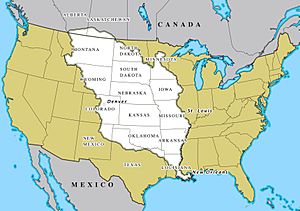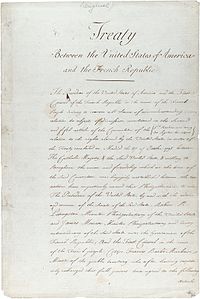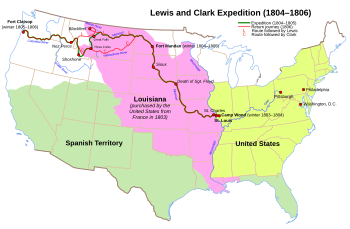Louisiana Purchase facts for kids
Quick facts for kids Louisiana PurchaseVente de la Louisiane |
|||||||||||
|---|---|---|---|---|---|---|---|---|---|---|---|
| Expansion of the United States | |||||||||||
| 1803–1804 | |||||||||||
 Modern map of the United States overlapped with territory bought in the Louisiana Purchase (in white) |
|||||||||||
| History | |||||||||||
|
• Established
|
4 July 1803 | ||||||||||
|
• Disestablished
|
1 October 1804 | ||||||||||
|
|||||||||||
| Today part of | |||||||||||
The Louisiana Purchase (French: Vente de la Louisiane, lit. 'Sale of Louisiana') was the purchase of the territory of Louisiana by the United States from the French First Republic in 1803. The U.S. purchased 828,000 square miles of land for $15 million ($293,133,333 in 2025). The purchase nearly doubled the size of the United States. The land began on the west side of the Mississippi River and went westward to the Rocky Mountains, northward to the Canadian border, and southward to the Gulf of Mexico. It included the important city of New Orleans.
Contents
Background
The section of land that was included in the Louisiana Purchase was controlled by the Kingdom of France in 1699. The land was surrendered to Spain in 1762, and French Emperor Napoleon Bonaparte purchased the land back from Spain. Until the purchase, the Americans controlled the area east of the Mississippi and north of New Orleans.
America was growing rapidly, and settlers needed more room to expand. It also wanted to own New Orleans because it had a port that could be used to send products up and down the Mississippi River to other areas of the U.S. The port could also be used for foreign trade.
Negotiation and Purchase
President Thomas Jefferson had heard that Napoleon wanted to keep the Louisiana Territory to create a French Empire in the United States. He thought that the territory would need to be purchased in small pieces. President Jefferson sent Robert R. Livingston to France to purchase New Orleans for $10 million. However, because of Napoleon's war debt from the Great French War and because he thought selling the land to the U.S. would make England (his enemy) angry, he offered the rest of the Louisiana Territory to the U.S. for $5 million more. The treaty that was signed to buy the land was approved by the U.S. Senate in October, and the U.S. flag was raised over New Orleans on December 20.
Congresssional concerns
- Many in Congress said that the U.S. Constitution did not talk about the federal government buying land from a foreign power.
- They were afraid that Spain would be angry. They thought Spain would want the land back and that Spain did not want Napoleon to afford to continue his war and possibly include them in it.
- Congress did not know what would be done with the French, Mexican, and Spanish people already living there. Would they become U.S. citizens? At the time of the purchase, the territory of Louisiana's non-native population was around 60,000 people, of whom half were enslaved Africans.
- Congress was concerned that the settlers who moved that far west would not remain loyal to the United States.
- The issue of slavery would need to be addressed. The North and South were already in disagreement about slavery. What would be done with the African slaves who were living on the territory?
Jefferson's solutions
- Because the U.S. Constitution did not talk about the federal government buying land from a foreign power, Jefferson bought the land with the power to make treaties. Article II, Section 2, of the Constitution specifically grants the president the power to negotiate treaties, which is what Jefferson did.
- Even though Spain was angry, James Madison reminded them that the United States had first approached Spain about purchasing the property, but had been told by Spain itself that the U.S. would have to sign a treaty with France for the territory. Therefore, Spain had no more rights to the land.
- Congress made temporary rules for local civil government to continue as it had under French and Spanish rule and gave permission to the president to use military forces to keep order.
- The military would help maintain order as the government would learn more about the land and map it to be sure they could control it.
- As parts of the territory became states, they were allowed to determine for themselves the position they would hold on slavery.
Expeditions
President Jefferson decided that to govern the land he had just purchased, he needed to know more about it. He sent men to explore and map the country west of the Mississippi so settlers could live there and be governed well.
The most famous expedition was the Lewis and Clark Expedition, led by Meriwether Lewis and William Clark. It left Saint Louis, Missouri, in 1804, leading a group of 33 people. The group reached the Pacific in 1806. They met several Native American tribes along the way and were guided in part of their journey by a Shoshone Native American Woman named Sacagawea.
The Red River Expedition in 1806 was one of the first civilian scientific expeditions to explore the Southwestern United States. It was ordered to find and map the headwaters of the Red River from the Mississippi River as a possible trading route to Santa Fe, then under Spanish colonial control in New Mexico.
The Pike Expedition was led by led by United States Army Lieutenant Zebulon Pike. It was the first official American effort to explore the western Great Plains and the Rocky Mountains in present-day Colorado. Pike contacted several Native American tribes during his travels and told them that the U.S. now claimed their territory.
Impact on Native Americans
The Louisiana Purchase was arranged between France and the United States without talking to the various Indian tribes who lived on the land. They had not given the land to anyone. For forty years after the Louisiana Purchase, the U.S. government worked to remove many tribes from their lands east of the Mississippi. This resulted in the Trail of Tears.
Interesting facts about the Louisana Purchase
- René-Robert Cavelier, Sieur de La Salle led an expedition that canoed down the Mississippi River. He named the Mississippi basin "La Louisiane" (Louisiana) in honor of King Louis XIV and claimed it for France.
- The Louisiana Purchase was the first time the United States received territory by signing a treaty with another nation.
- The Louisiana Purchase cost the United States about 3 cents per acre, which was an amazing price.
- When Napoleon got the land back from Spain, he had the secret ambition to rebuild a French empire in America. He changed his mind due when he needed money to fight wars in Europe.
- Some historians believe that Napoleon Bonaparte had no right to sell the French-owned land to the United States.
- Napoleon’s brothers Joseph and Lucien found out about his plans to sell Louisiana and tried to talk him out of it.
- The treaty did not state specific boundaries. President Jefferson was quick to send expeditions to explore the land and mark boundaries.
- The land was rich in gold, silver, and many other ores.
Images for kids
-
1804 map of "Louisiana", bounded on the west by the Rocky Mountains
-
The future president James Monroe as envoy extraordinary and minister plenipotentiary to France helped Robert R. Livingston in negotiating the Louisiana Purchase
-
Transfer of Louisiana by Ford P. Kaiser for the Louisiana Purchase Exposition (1904)
-
Flag raising in the Place d'Armes of New Orleans, marking the transfer of sovereignty over French Louisiana to the United States, December 20, 1803, as depicted by Thure de Thulstrup
-
Plan of Fort Madison, built in 1808 to establish U.S. control over the northern part of the Louisiana Purchase, drawn 1810
-
Louisiana Purchase territory shown as American Indian land in Gratiot's map of the defenses of the western & north-western frontier, 1837.
See also
 In Spanish: Compra de Luisiana para niños
In Spanish: Compra de Luisiana para niños









